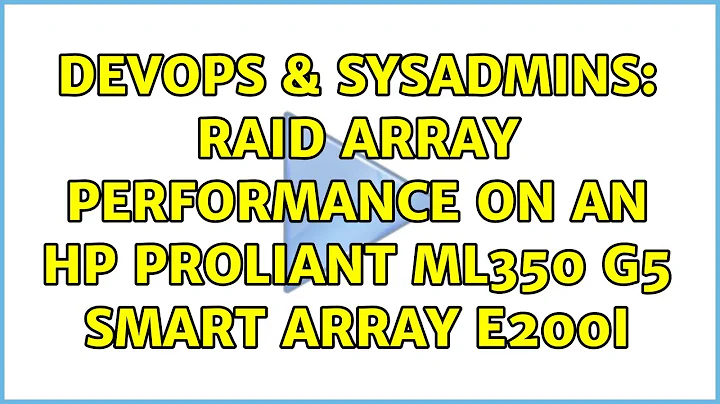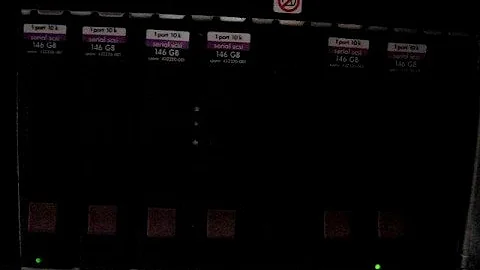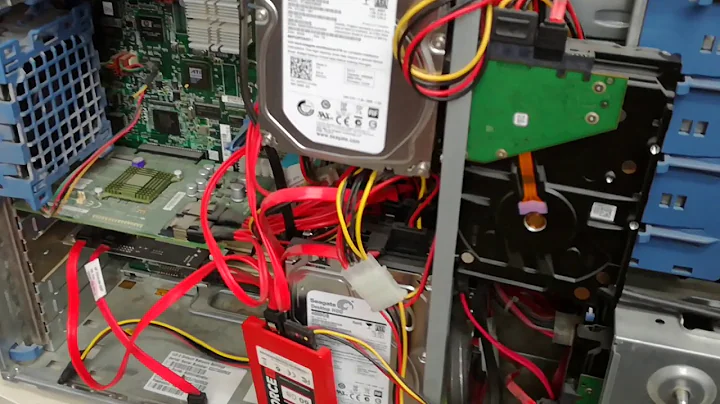RAID Array performance on an HP Proliant ML350 G5 Smart Array E200i
Solution 1
Too many imponderables. For example, how are the disks set up? If the logs and data share the same disks the random I/O from the data areas will disrupt the log traffic, which is mostly sequential I/O and is disproportionately affected by a busy random access workload on the same disks.
Without some more insight into your configuration I can't really say what might be causing the problem.
For example, 60MB/sec off a RAID is about right for a 4-disk RAID-5 or RAID-10 with 64k stripes and 15k drives. Each drive will read one 64k stripe per revolution of the disk (about 250/sec for a 15k drive) which gives you 15MB/sec per drive.
The average seek time for a 15k disk is around 3ms across the whole disk. On a mostly contiguous 10GB file on a RAID volume with (say) 146GB or 300GB disks and a bit of help from the cache I could see 30MB/sec being a reasonable figure for a disk array configured as described above. It would indicate averaging a data read about every two revolutions of the disks.
That's a thought off the top of my head for a configuration one might reasonably expect to see on an ML350. However, I have no idea if that matches your actual configuration, so I can't really comment on whether the observations are relevant in your case.
Solution 2
The E200i has notoriously poor performance, as documented by Lukas here and Ryan here. Check you've got the optional battery kit (BBWC) attached and the HP Array Configuration Utility is showing the battery status is ok. (In HP Array Configuration Utility click on the Controller in the Configuration View in the center and choose More Information on the Common Tasks menu on the right). Having this Battery in place gives the disk controller a good boost in performance.
But your best bet is going to be to swap out the E200 with a 'proper' HP SmartArray controller, the P400 or P600's with the 512MB BBWC should give you a good speed boost.
Solution 3
Below is a benchmark we did with similar hardware, and a few differences noted. I would guess some of the performance hit is due to the partitions are misaligned (Windows 2003 misaligns partitions by default). Run the following command, and if the starting offset is 32256, it is misaligned.
wmic partition get index, blocksize, name, startingoffset
To properly align the partitions, you need to use the DISKPART utility.
Test Hardware:
HP DL380 G5
2 sockets, 4 total cores
16GB of RAM
HP P400 controller
512MB cache
25% Read / 75% Write
10K RPM HDDs
Windows Server 2003, 32-bit
Five-minute test cycle
Results (MBytes/second):
(RS: Read Sequential RR: Random Read WS: Write Sequential WR: Write Random)
Raid5 3 HD:
RS 180
RR 180
WS 120
WR 130
Raid5 4 HD:
RS: 240
RR: 260
WS: 175
WR: 180
Raid5 5 HD:
RS: 310
RR: 320
WS: 210
WR: 225
Solution 4
You should not be having a "pseudo-degraded" Raid5 as a database backing store. AFAIK is the slowest possible disk configuration. Add in a low end controller and things will not get better.
Hitachi AMS owners can ignore this posting (4disk raid5 = above 300MB/s). For the rest it probably applies.
Solution 5
Does the Smart Array E200i have a backup battery write cache installed? I have seen some dire performance out of Smart Array controlers without a BBWC.
As for the data rate readings you took, I can't really comment I have seen 60 MB/sec out of a high end desktop system. However data rate readings can lie! Post up the parameters for the tool you used for a better comparison.
Related videos on Youtube
dav
Updated on September 17, 2022Comments
-
dav over 1 year
I have a report.php file created in
app/vendors/shellsfolder with the following contentclass ReportShell extends Shell { var $uses = array('User'); function main() { $userData = $this->User->find('first'); } }when I want to run it from app folder
../cake/console/cake reportI get the following errorError: Missing database table 'users' for model 'User'userstable does exist in db,Usermodel as well. And the project works fine, I mean there are no issues with models, controllers, views. My cake version is 1.3Thanks
-
Nate Pinchot almost 14 yearsGood call, sorry for not including that in the first place.
-
 Philip almost 14 yearsThe disk performance sounds on-par for an E200 and 3 10k SAS drives. It sounds like the application needs a "faster" disk setup to improve performance (or the app is just poorly written, very hard to say without knowing how it works). Switching to a P600 or P800 would make a small improvement, more disks in a RAID 10 would make more improvement.
Philip almost 14 yearsThe disk performance sounds on-par for an E200 and 3 10k SAS drives. It sounds like the application needs a "faster" disk setup to improve performance (or the app is just poorly written, very hard to say without knowing how it works). Switching to a P600 or P800 would make a small improvement, more disks in a RAID 10 would make more improvement. -
Nate Pinchot almost 14 yearsThe app is terribly written - it runs the same query that takes 50+ seconds to execute, 6 times in a row, no more than a second after it completes. It has clustered indexes on nvarchar(40) which are 95% null values. It constantly searches on non-indexed columns. We are not allowed to adjust these because the client's friend wrote the app and that person walks on water as far as they are concerned.
-
Costa about 11 yearsTry checking what db config it's using by running
debug(ConnectionManager::enumConnectionObjects());. Or maybe it's probably not finding the User model and creating one on the fly -- try creating a custom function in the User model and calling it from the shell to see if it's seen. -
dav about 11 yearsThanks @Costa for your comment, debug results($result) contains
$result['config']array according to my$defaultconfiguration, so it's ok, I have also created another model with$useTable = false, and a custom function in it, that worked fine, so it can use model, but as before, fails to finduserstable -
dav about 11 yearsThanks @Costa for your help, I figured it out
-
-
Nate Pinchot almost 14 yearsMy apologies for not including more detail on the hardware configuration. There are three, 146 GB SAS 10k RPM 3.0 GB/sec (model HP DG146BABCF) drives, configured in a RAID 5 array. These are the only physical disks available to the server so both logs and data, including operating system data and paging file are all on the same physical disk array (there are 2 logical drives with the OS data being separate). The array stripe size is set to 64k. Total usable space is 273 GB.
-
Nate Pinchot almost 14 yearsThe controller does have the battery pack installed. The parameters are in the link for the guide, I copied his batch file verbatim (changing the drive letter of course).
-
Nate Pinchot almost 14 yearsThe battery pack is installed and the status is okay. I'll check out the P400 and the P600, thanks.
-
pauska almost 14 yearsLogs on RAID5 is not a recommended practice, logs and data on the same arry is not recommended and finally; OS and logs and data on the same array is not recommended.
-
Dave M almost 14 years+1 We have strugged with this and this comes up in HP forums. Never found a great fix. The upgraded cards seem to be the answer.
-
Nate Pinchot almost 14 yearsIndeed :) I guess I should have mentioned that at this point we are kind of at arms with the client arguing that the software is not the issue and the servers are not performing as well as they should (so in turn they are not currently willing to spend money to do hardware upgrades) - I am just trying to prove to the client that the server is performing optimally with the hardware available, because they believe that it is not.
-
Nate Pinchot almost 14 yearsDo you think there would be considerable performance increase if we upgraded only the controller to the P400 or P600? At less than $1000 I might be able to convince them to get just the controller. Or would it be a negligible performance increase by only upgrading the controller?
-
Nate Pinchot almost 14 yearsNever mind that last comment, I see Chris S above said swapping out the controller would probably only make a small improvement.
-
Nate Pinchot almost 14 yearsSelected this as the answer because it more accurately addresses the original question, but @steveburkett's answer below is extremely relevant to the situation as well.
-
Nate Pinchot almost 14 yearsThanks for the information. Ran the wmic command above - StartingOffset is 16384. What is the proper StartingOffset? Thanks for the performance benchmark as well, I may consider asking the client to try upgrading only the controller and keep the current drives - since that is a sub $1000 upgrade they may go for it.
-
Greg Askew almost 14 yearsHere is an excellent article on calculating partition offset. Note that in Windows Vista/7/2008, the starting offset is 1 MByte (1048576 bytes) (properly aligned). msdn.microsoft.com/en-us/library/dd758814.aspx
-
Greg Askew almost 14 yearsYou may also want to run fsutil fsinfo ntfsinfo x: , where x: is your partition(s). This will confirm your NTFS allocation unit size. If it is 64k, which is a best practice for SQL, I would want something larger than 16384 for the starting offset.




